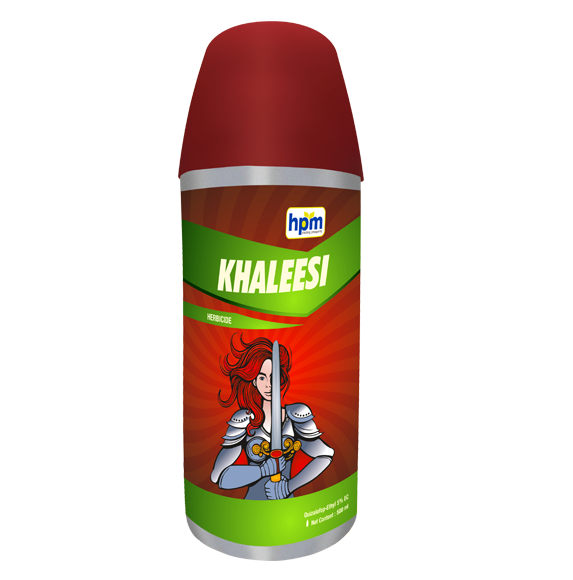- HOME
- ABOUT
- INFRA
- BUSINESS AREA
- KNOWLEDGE
- CSR
- Policy & Committe
- Activities
- Plantation Drive(Samba)
- Green Nation Clean Nation Plantation Drive
- Santosh Krishi Diwas
- 14 TH SENIOR ROLL BALL NATIONAL CHAMPIONSHIP
- Arm Wrestling Championship
- Clothes Distribution for Students
- Samuhik Vivah Bhiwadi
- Help him to Breathe
- WHEELCHAIR DISTRIBUTION KHUSHKHERA
- Girl's Adoption CSR
- Save Eyes Save Life
- CAREERS & HR
- NEWS
- CONTACT
- BLOG
QUESTIONS? CALL: 011-4507 1800

Stands for delivering best service and exceptional quality for crop protection.
Tel. (911) 45071800-899
Email: info@hpmindia.com
HPM Chemicals & Fertilizers Ltd.
209-210, Anupam Bhawan, Azadpur Commercial Complex Azadpur, Delhi-110033
Khaleesi is Quizalofop ethyl 5% EC as formulation.
- It is a selective post-emergence systemic herbicide.
- It is used to control narrow leaf weeds and grassy weeds in soybean, black gram, onion, cotton and groundnut crops.
- Khaleesi is suggestive to spray at 20-25 days after sowing with the help of knapsack sprayer using float fan nozzle..
- Khaleesi is absorbed & translocated very rapidly by the weeds and eradicate the weeds. The affected weeds are unable to rejuvenate.
- Quick absorbing property of Khaleesi provides rain fastness for even one hour of spray.
- The affected weeds become purple/red in 4-7 days after application and dies totally in 10-15 days.
- Khaleesi is available in 250 ml, 500 ml and 1 liter packing.

| Product Name |
: |
Quizalofop ethyl 5% EC | |||||
| Type of pesticide |
: |
Herbicides | |||||
| Chemical name |
: |
ethyl 2-(4-((6-chloro-2-quinoxalinyl)oxy)phenoxy)propanoate | |||||
| Empirical Formula |
: |
C8C19H17ClN2O4 |
|||||
| CAS No. |
: |
[76578-14-8] | |||||
| UN No |
: |
3082 | |||||
| Packing group |
: |
III | |||||
| IMDG |
: |
Class-9[Environmentally hazardous substance, liquid, n.o.s. ( Quizalofop-Ethyl)] | |||||
| Shelf-life |
: |
Two years under normal storage conditions. | |||||
|
DESCRIPTION |
|||||||
| It belongs to aryloxyphenoxypropionate family. It works as Acetyl CoA carboxylase inhibitor, it inhibits the biosynthesis of fatty acid. | |||||||
| Mode of action | |||||||
| It is systemic herbicide, absorbed from the leaf surface, with translocation throughout the plant, moving in both the xylem and phloem, and accumulating in the meristematic tissue. | |||||||
| Applications Quizalofop-ethyf 5 % EC, based on Ethyl 2 -(4-6- Chloroquinoxalin- 2 yloxy) phenoxy} propiohate, is used as post-emergence herbicide for the effective control of grassy weeds in soybean crop.Spray 20-25 days after sowing with the help of knaspsack sprayer using float fan nozzle. | |||||||
| Structure Formula |
: |

|
|||||
| Physical Properties | |||||||
| Appearance |
: |
white to pale yellow fine crystalline solid | |||||
| Quizalofop ethyl content, percent by mass |
|
92.0% Min. | |||||
| Melting Point |
: |
Molecular weight: 372.8 g/mol | |||||
| Solubility In Water: |
: |
0.61mg/L 20℃ | |||||
| Compatibility |
: |
Compatible with other herbicide. | |||||
| TOXICITY DATA | |||||||
| Mammalian Toxicity |
: |
WHO (a.i.) III; Slightly Hazardous | |||||
| Environmental Toxicity |
: |
In mammals, following oral administration, the parent is rapidly metabolised and eliminated within 3 days. In broad-leaved plants, absorption and translocation are very limited. It is moderate to slightly toxic for mammals. It is slightly toxic for birds. It is highly toxic for aquatic animals. It is slightly toxic for bees. | |||||
| Formulation |
: |
75% WG | |||||
| Trade name |
: |
TARGET | |||||
| Packing detail |
: |
13.5gm, 6.75gm | |||||
| Recommendations | |||||||
| Crop | Weed Species | Dosage/acre(ml) | Dilution in Water (Liter) |
Waiting Period
(days |
|||
|
Soybean
|
Echinochloacrusgalli and E. colonum(harmyard grass). Digitarlasangulnallis (Crab grass), Eragrostis sp.(Love grass) | 200-240 | 300-400 | Na | |||
| Name | Details |
|---|---|
| UID | HPM2000K044 |
| Brand Name | Khaleesi |
| Technical Name | Quizalofop- Ethyl 5% w/w EC |
| Packing Details | 1 Ltr, 500 ml, 250 ml, 100 ml. |
| Production Plant | HPM Khushkhera |
| Registration No | CIR-194504/2021-Quizalofop-Ethyl (EC) (432)-86 |
| Toxicity Symbol |  |







